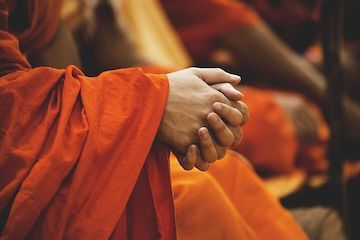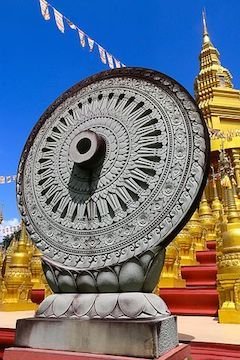The Buddhist 10 Fold Path
RIGHT INTENTION / THOUGHT

Right view is the forerunner of right intention in the Eight Fold Path and the direct condition for right intention. This is explained in the Anguttara Nikaya:
“Monks, just as the dawn is the forerunner and precursor of the sunrise, so right view is the forerunner and precursor of wholesome qualities. For one of right view, right intention originates. For one of right intention, right speech originates.” AN V.237
Together with the previously discussed right view, right intention makes up the aggregate of wisdom, being part of the three aggregates of training. This is detailed in the Majjhima Nikaya:

“Right speech, right action, and right livelihood — these states are included in the aggregate of virtue. Right effort, right mindfulness, and right concentration — these states are included in the aggregate of concentration. Right view and right intention — these states are included in the aggregate of wisdom.” - MN I.301
The relationship in discourse between right view and right intention is setup nicely, as well as explaining what wrong intention is and what right intention is:

“Therein, monks, right view comes first. And how does right view come first? One understands wrong intention as wrong intention and right intention as right intention.” — MN I.73
The wrong intention is to be abandoned and it’s three types of wholesome thoughts as antidotes to be applied and practiced:

“And what, monks, is wrong intention? The intention of sensual desire, the intention of ill will, and the intention of cruelty.” — MN I.73
The right intention has two types and one might presume that for the beginner in Buddhism the first type is to be started with as a preliminary steps to the second type:

“And what, monks, is right intention? Right intention, I say, is two-fold: there is right intention that is affected by taints, partaking of merit, ripening in the acquisitions, and there is right intention that is noble, taintless, supra-mundane, a factor of the path.” — MN I.73
“And what, monks, is right intention that is affected by taints, partaking of merit, ripening in the acquisitions? The intention of renunciation, the intention of non-ill will, and the intention of non-cruelty.” — MN I.73
“And what, monks, is right intention that is noble, taintless, supra-mundane, a factor of the path? The thinking, thought, intention, mental absorption, mental fixity, directing of mind, verbal formation in one whose mind is noble, whose mind is taintless, who possesses the noble path and is developing the noble path.” — MN I.73
In the preliminary phase of practice, the three mundane right intentions arise separately, but at the moment of the supra-mundane path, a single right intention arises and cuts off the three-fold wrong intention, as mentioned previously, completely.
Right intention leads to wholesome qualities of a person and these should be developed and are beneficial:

“The numerous bad unwholesome qualities that originate with wrong intention as condition: these are harmful. The numerous wholesome qualities that reach fulfillment by development with right intention as condition: these are beneficial.” — AN V.223
Overall, the first two steps of the Eight Fold Path apply in practice to the three types of actions (kamma):

“Monks, for a person of right view, right intention, right speech, right action, right livelihood, right effort, right mindful- ness, right concentration, right knowledge, and right liberation, whatever bodily kamma, verbal kamma, and mental kamma he instigates and undertakes in accordance with that view, and whatever his volition, yearning, inclination, and volitional activities, all lead to what is wished for, desired, and agreeable, to well-being and happiness. For what reason? Because the view is good.” — AN V.213
A special note about the taints (asavas): To give an idea of what the taints are, they consist of: craving for sensual pleasures, craving for continued existence, and ignorance. Other groups of defilements that overlap the taints include:

The Four Bonds (yoga): The bond of sensuality, the bond of existence, the bond of (wrong) views, and the bond of ignorance.
The Seven Underlying Tendencies (anusaya): The underlying tendency to sensual lust, the underlying tendency to aversion, the underlying tendency to (wrong) views, the underlying tendency to doubt, the underlying tendency to conceit, the underlying tendency to lust for existence, and the underlying tendency to ignorance.
The Ten Fetters (5 higher (uddhambhagiya) + 5 lower (orambhagiya)): Personal-existence view, doubt, wrong grasp of behavior and observances, sensual desire, and ill will; lust for form, lust for the formless, conceit, restlessness, and ignorance.
In the next post No. 3 of the path will be discussed: Right speech.
The following English translations of the primary texts are available and used:
The Connected Discourses of the Buddha: A Translation of the Samyutta Nikaya (SN)
The Long Discourses of the Buddha: A Translation of the Digha Nikaya (DN)
The Middle-Length Discourses of the Buddha: A Translation of the Majjhima Nikaya (MN)
The Numerical Discourses of the Buddha: A Translation of the Anguttara Nikaya (AN)
The Eight Fold Path consists of:
- Right view (samma ditthi, but also samma dassana)
- Right intention (samma sankappa)
- Right speech (samma vaca)
- Right action (samma kammanta)
- Right livelihood (samma ajiva)
- Right effort (samma vayama)
- Right mindfulness (samma sati)
- Right concentration (samma samadhi)

The Ten Fold Path consists of two additional ‘folds’:
9. Right knowledge (samma nana)
10. Right liberation (samma vimutti)


 A link to My Blog
A link to My Blog
I've really been out of touch. I haven't heard true discussions of Buddhism in personal behavior since 1972. A little bit of intellectual "life coach" hogwash here and there, but not the basic truth that we trend towards unenlightened lives and will not have enlightened lives without practice. Thanks.
Can you imagine me a redneck hillbilly from rural Oregon knocking at a Korean Zen temples door and asking for teachings? I was so scared I grew up in a Christian community and had not known any other cultures and I was 30 years old.
My life was so miserable and I knew my choices were causing my misery but I didn't know how to break away from my negative conditioning. Breaking the knots of trauma (PTSD) from childhood abuse and living in a really screwed up society.
I found out about Buddhism when I read a book about religions from my public library. Since everything I had tried including therapy, antidepressant medication for panic attacks, and self help books didn't help me I decided to give the Dhamma a try. I had to ask 3 times and no monks spoke English except Sunim who moved to the Zen Center 2 weeks prior to me knocking at his door!
These post are made in gratitude to my awesome teachers.
Yes, yes I can 8-)
I was a 13 year old redneck Florida Cracker living on the streets and eating out of trash cans when I just kept staying overnight at the Baba Sri Chand Ashram until they started feeding me and teaching me. They also shared space with a Judo and Shiatsu instructor who introduced me to Buddhism and was the only serious instruction I ever had. I guess I just assumed that I knew enough since my life got better.
I could not take seriously the effete and ignorant "counselors" who bastardized it into "mindfulness" in the 80s. So I never really looked at it further. I probably should now that the Internet exists.
Wow you had a rough childhood too. I know so many people who found help through Ashrams or Buddhist centers. I've heard so many people's stories about detoxing during retreat. Something that I wouldn't do and I won't promote. It's hard on the centers, most won't let anyone in if they have addictions or mental problems.
And then I know so many people who have been abused by bad teachers as well. I think it's all about one's Karma how they experience the dharma. I think you have really good karma @baerdric!
All correct paths are the symbol of peace.The main motto of achieving success in the right path.
In the oldest Pali text nibbana is never mentioned, it's the path that is often mentioned. Thank you @prova.
I have read on the internet about this leaf. is it true this plant for the budha people.
Yes @papma, it is the symbol for the Dhamma teachings and Buddha's enlightenment.
yes.
we are different religions but respect each other and complement each other.
hug
@reddust,
I assure you my dear friend, this is the first time I have seen a European described Buddhism in this deep! Great work and thank you very much!
You can thank my teacher Sunim a Korean Monk and SN Goenka from Burma, my meditation teacher. Thank you @theguruasia.
Interesting post. Again read. Thanks shared @reddust Mevlana says:
A candle doesn’t loose its light, by enlightening another candle.
This quote touched my heart thank you @turkishcrew.
You would think most folks would have the right intentions. But I suppose free will can create selfishness. Thanks for sharing @reddust.
free will gives us the chance to make choices, these choices will either produce bitter fruit, sweet fruit, or no fruit at all...hahaha
@reddust..............a very nice article about intention...........i appreciate you....overall,,always lead our life the right way,,right intention,, right speech,, and the most important right action....then it can make a happy life....thanks for your great share.......
Everyone can use this path no matter their religious on non religious views. I found peace of mind studying the text and trying to apply the knowledge to my life.
I can see the hard work you have put here to make this post so much elaborative and expressed. You must have read the Buddha's Teachings too closely and researched them.
My husband has studied Buddhism as long as I have, he is my researcher for Pali citations and editor for the text. I should have him edit my other papers as well. We both have been studying Buddhism for over 20 years each.
Have you also studied Hinduism?
I feel one step closer to be fully enlighted. Thank you sensei Reddust!
I wish you all be best...
https://www.accesstoinsight.org/lib/authors/thanissaro/nibbana.html
we are unfolding a new path everyday thanks goes to you for sharing such an amazing post learning along the path :)
Thank you @blazing